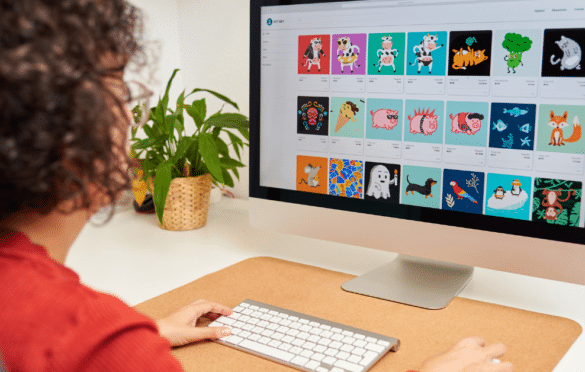We’ll be talking about the most popular NFT use cases and how each one is unique in its own way.
Art NFTs:
Crypto art is viewed as creditable based on its authenticity and ownership shown digitally. While art can be copied and an image can be saved, there is no proof that it’s original. Speaking of NFTs, we’re not focusing on the artwork itself. The more important aspect is the proof of ownership. This is essentially what makes crypto art one of the most popular NFT use cases today.
Collectible NFTs:
NFT collectibles have brought about massive demand. Collectibles became even more common once trading cards called the NBA Top Shot were introduced. These NFT collectibles make up significant sales on marketplaces such as Opensea, BakerySwap, and Treasureland. Often an NFT can be a collectible as well as an art piece.
Finance NFTs:
NFTs also bring significant financial benefits in decentralized finance (Defi). Most will have some artwork, but their utility usually determines their worth. JustLiquidity, for example, provides an NFT staking mechanism. A user can stake a pair of tokens in a pool for a set period and obtain an NFT that allows them to enter the following collection. It is essentially an entry pass, and once entering the new pool, it loses validity. The access these NFTs offer develops a secondary market for them.
Another example is BakerySwap’s NFT food combinations, which offer staking rewards to its holders. You will receive an NFT combination with variable staking power if you contribute BAKE. Users speculate on these by selling them on the secondary market or staking them. This mix of non-fungible tokens, gamification, and Defi presents another intriguing option for NFT use cases.
Gaming NFTs:
Gaming, in particular, comes in massive demand for unique items. Gamers have become familiar with this concept of valuable, tradeable, and purchasable digital items. It’s also an interesting topic in terms of NFT. Tokens for video games mix art, collectability, and player usefulness elements. However, NFT adoption in big-budget video games seems a long way off. Meanwhile, two projects have been on the blockchain technology bandwagon, Axie Infinity, and Battle Pets. These are Pokémon style games; the game includes tradeable pets, enabling gamers to purchase and sell these tokens on other marketplaces.
Music NFTs:
Like an image and video, music can also be “copied” to an NFT to create a collectible piece of music. Getting a fair portion of royalties is a major concern for musicians. However, at least two solutions are present, blockchain-based streaming networks and blockchain royalty monitoring. In the meantime, Rocki on the Binance Smart Chain enables independents to sell and stream their music. Using the ERC721 token standard, their first royalty NFT sale on the platform left them with a gain of 40 ETH for 50 percent royalties. Depending on its adoption by the large streaming platform, we will see its potential for popularity. This can be a clever NFT use case; however, it might be hard to succeed in this realm without the support of music labels.
Real World Asset NFTs:
In real estate, the properties we deal with are physical such as a piece of land or a house. Creating a tokenized digital asset moves the “property” onto the blockchain. For real-world asset NFTs, regulators have not provided enough support. It can become more popular over time as it develops. Smaller items such as jewelry can prove ownership when reselling.
A genuine, ethical diamond, for example, generally comes with a certificate of authenticity. This certificate also serves as proof of ownership rights. Anyone attempting to sell the item without the certificate will have no way to guarantee its authenticity and may have difficulty convincing buyers that they are the legitimate owner.
The same is true when it comes to NFTs. When an NFT is associated with an item owning the NFT is just as important as the asset itself. It essentially is its certificate of ownership.
Logistics NFTs:
Because of its immutability and transparency, blockchain technology can also be effective in the logistics business. These factors ensure that supply chain data stays legitimate and trustworthy. It’s critical to know where food, commodities, and other perishable things have been and for how long. An NFT may be used to track a product that has meta-data about its origins, travel, and warehousing location. With so many diverse parties and stakeholders involved globally, putting these systems into action may be difficult. This factor has resulted in a small number of real-world usage cases.
While this is the current list of NFT use cases, its popularity is still growing, and there’s a chance that more ideas will come about in the future. Some may not be as popular or successful; however, they are here to stay for art and collectibles.

